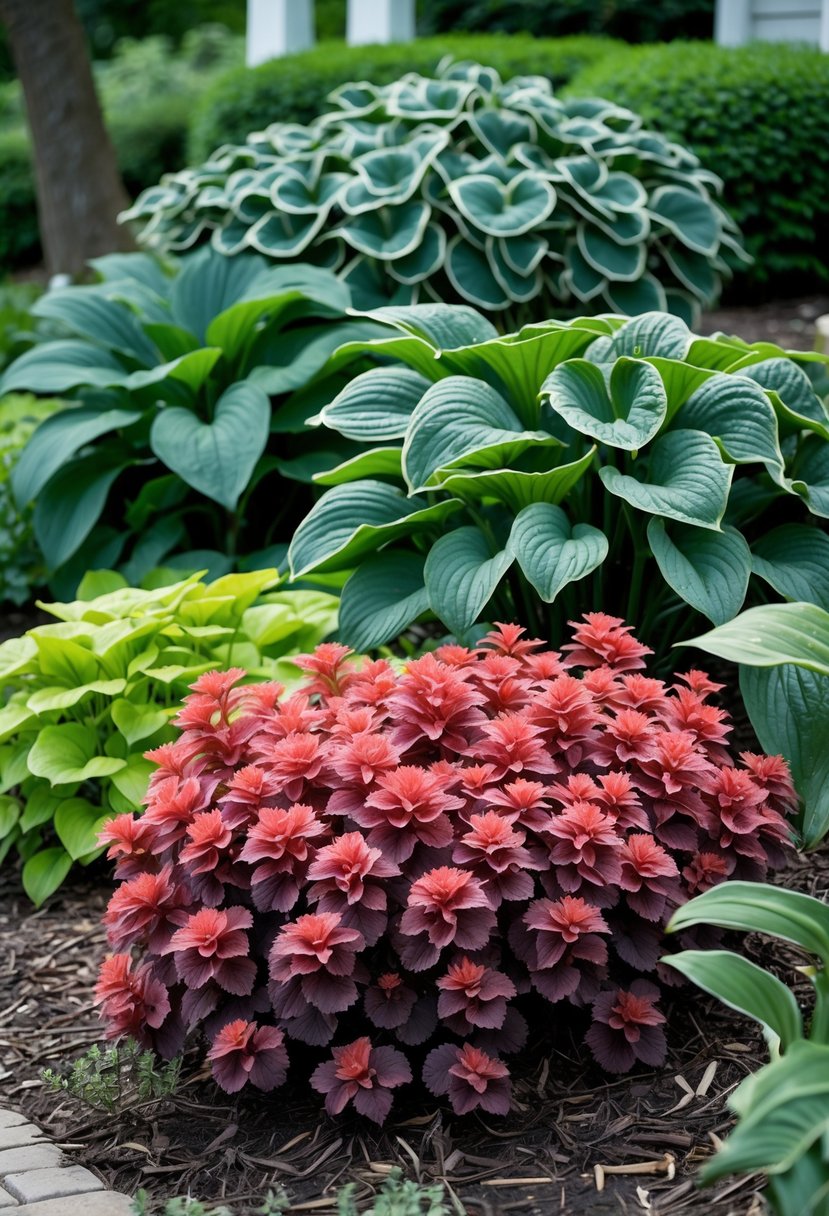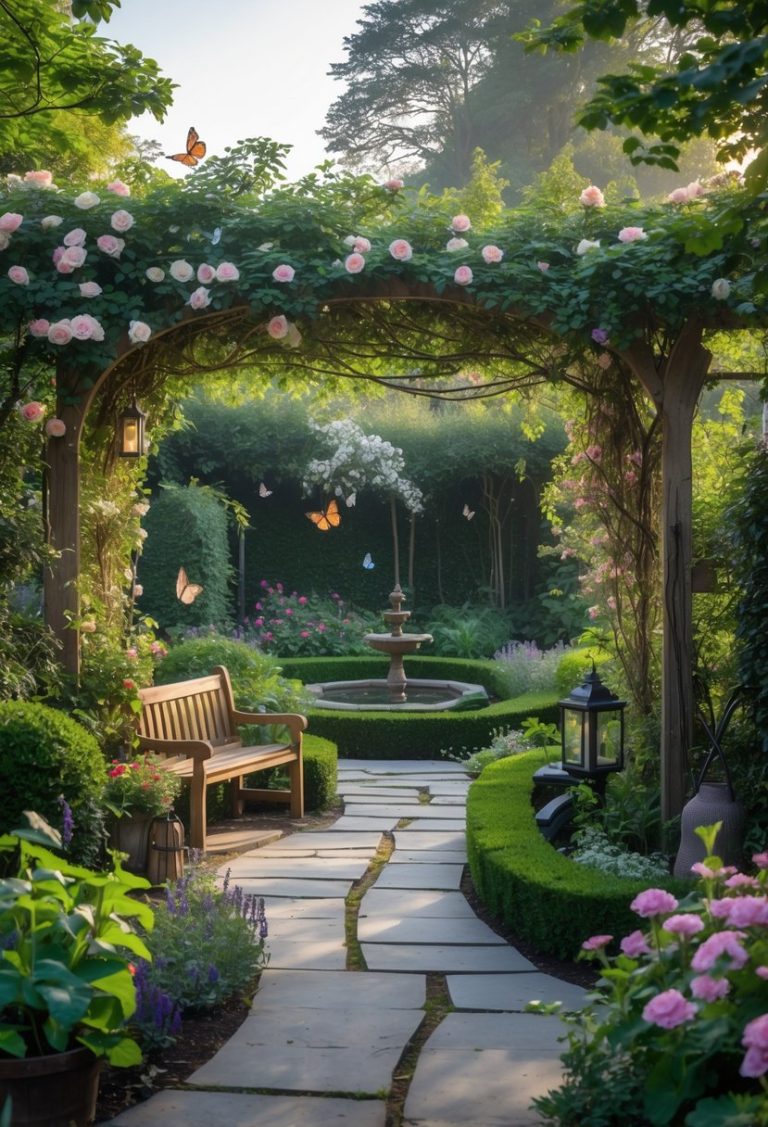10 Coral Bells Front Yard Landscaping Ideas to Enhance Curb Appeal and Texture
If you want to make your front yard more colorful and inviting, coral bells are a great choice. These plants come in many shades and add texture and life to your garden without needing a lot of care.

Using coral bells in your landscaping can enhance your yard’s look with bright colors and year-round interest. They work well with other plants and fit different garden styles, making them a smart option for any homeowner.
1) Use deep burgundy Coral Bells to create a striking contrast in your front yard planting beds.

You can add strong color to your front yard by planting deep burgundy coral bells. Their dark leaves stand out well against green plants and bright flowers. This contrast draws attention and adds interest to your beds.
Place these coral bells near lighter-colored plants to highlight their rich red tones. They work well at the front edge of beds or around pathways.
These plants prefer dappled sunlight but can tolerate some shade. Their low-growing habit helps keep your garden neat and colorful.
2) Plant Coral Bells 12-18 inches apart for a dense, colorful border.

You should space coral bells 12 to 18 inches apart when planting. This distance lets the plants grow fully without crowding each other. It also helps with airflow, reducing the chance of disease.
Planting them close creates a thick, bright border. Over time, their leaves and flowers fill in the gaps. This gives your front yard a neat and colorful look.
Make sure to plant coral bells in early spring or fall. Cooler temperatures help the roots establish well. Proper spacing and timing make your coral bells thrive.
3) Combine Coral Bells with hostas to add lush texture and fill in shady spots

You can use coral bells and hostas together to create a rich look in shady areas of your yard. Hostas have large, thick leaves that provide a strong green backdrop. Coral bells offer colorful foliage that contrasts well with hostas.
This combination adds depth because their leaf shapes and colors are different. Coral bells come in many shades, from deep purples to bright greens, which brighten shaded spots. Hostas help fill space with their larger leaves.
Both plants like similar conditions, such as partial to full shade and moist soil. This makes it easy to care for them together. You can plant them in clusters or along borders to make your shady spots look full and inviting.
4) Layer Coral Bells with taller fountain grass for volume and movement near your mailbox.

You can create a simple but attractive look by planting coral bells near your mailbox. Use taller fountain grass behind the coral bells to add height and texture. This combination helps to create depth and makes the area look fuller.
Fountain grass moves gently in the wind, which adds soft motion to your front yard. Coral bells come in colors like deep burgundy, which contrast nicely with the green shades of the grass.
Plant the coral bells about 12 to 18 inches apart. This spacing lets each plant grow without overcrowding. The layered effect will draw attention to your mailbox naturally, making it stand out without overpowering the space.
5) Incorporate chartreuse Coral Bells varieties to brighten shaded front yard areas

Using chartreuse Coral Bells is a smart way to add light and color to shaded parts of your front yard. Their bright green-yellow leaves stand out against darker plants.
These varieties work well in spots with partial shade, where morning sun can help them show their best colors. You can plant them along paths or near entryways to catch the eye.
Chartreuse Coral Bells also change color with the seasons, adding interest throughout the year. Their color can range from pale yellow-green to brighter lime shades. This makes your shaded garden more lively without needing extra flowers.
6) Add Coral Bells near front porch steps paired with ferns for a welcoming entrance

You can create a warm and inviting entrance by planting coral bells near your front porch steps. Coral bells have bright, colorful leaves that add interest to any space.
Pairing them with ferns works well because both plants like similar shady and moist conditions. The ferns’ arching leaves contrast nicely with the rounded leaves of coral bells.
This combination is easy to maintain and looks good all season. It helps to soften the edges of your porch steps and gives guests a friendly welcome when they arrive.
7) Use Dolce® Coral Bells in containers to soften walkways and front porch planters.

You can use Dolce® Coral Bells in containers along walkways or on your front porch to add color and texture. Their smaller size fits well in pots, making them easy to arrange with other plants.
The rounded leaves and vibrant colors create a soft look that balances hard surfaces like concrete or wood. Placing these containers near your entryway can make the space feel more welcoming and lively.
Dolce® Coral Bells need regular watering and part shade to thrive. They work well with ferns, hostas, or small evergreens to keep your planters looking interesting all season.
8) Plant Coral Bells alongside astilbe to create feathery, colorful shade garden combinations

You can create an attractive shade garden by planting coral bells with astilbe. Astilbe’s feathery flowers add a soft, delicate texture that contrasts well with coral bells’ rounded leaves. This mix brings color and shape variety to your garden.
Both plants prefer similar conditions. They thrive in partial shade and moist soil, making them easy to grow together. Astilbe usually grows taller, so you can position coral bells in front to create depth and layers.
Together, they offer a long season of interest. Choose different astilbe varieties to extend bloom times. This pairing adds subtle color and texture without much extra care, making your front yard garden inviting and well-balanced.
9) Mix Coral Bells with Japanese forest grass for flowing foliage contrast in front yard beds.

You can create a nice contrast by planting coral bells with Japanese forest grass. The broad, colorful leaves of coral bells stand out against the fine, flowing blades of the grass. This mix adds both texture and color to your garden bed.
Japanese forest grass usually has golden or green tones that work well with the deep purples and reds of coral bells. Both plants prefer similar soil conditions, like moist, well-drained soil with a slightly acidic to neutral pH.
This pairing does well in part shade to shade areas. It helps keep your front yard looking full and healthy while offering visual interest through different leaf shapes and colors.
10) Choose smaller Coral Bells from the Primo collection for easy curb appeal landscaping

You can use smaller Coral Bells from the Primo collection to create neat and simple front yard designs. These plants stay compact, making them easy to place near walkways or at the front of flower beds.
Primo Coral Bells come in a variety of foliage colors, adding subtle variety without overwhelming your space. Their size helps you mix them with other plants without crowding.
These plants are low maintenance and work well in sun or part shade. Using Primo Coral Bells lets you build curb appeal with attractive, manageable plants that fit well in smaller or limited spaces.
Benefits of Using Coral Bells in Front Yard Landscaping

Coral bells offer various practical benefits for your front yard. They are easy to care for, support local wildlife, and provide color throughout different seasons.
Low Maintenance Appeal
Coral bells are known for being low maintenance. They grow well in shade or partial sun, depending on the variety, and don’t need frequent watering once established. You won’t have to spend much time pruning or fertilizing these plants.
Their evergreen foliage stays attractive year-round, reducing the need to replace plants each season. This makes coral bells ideal if you want a front yard that looks good without a lot of work.
Attracting Pollinators and Wildlife
Coral bells attract important pollinators like bees and butterflies with their small, bell-shaped flowers. This helps support the ecosystem right in your front yard.
Besides pollinators, their dense foliage can provide shelter for small wildlife. By planting coral bells, you encourage beneficial creatures which can improve the health of your garden.
Seasonal Interest and Color
Coral bells come in many colors and textures. Their leaves range from deep reds to bright greens, adding year-round visual interest to your yard.
You also get delicate flowers in late spring to summer. This seasonal bloom brightens your landscape when other plants may not be flowering.
Because of their color variety and evergreen nature, coral bells give your yard shifting shades and textures through different seasons.
Design Tips for Integrating Coral Bells

To use coral bells effectively in your front yard, focus on pairing them with the right plants, arranging them in layers, and creating contrast with their foliage. These details help your landscape look well-planned and inviting.
Choosing Complementary Plant Pairings
Pair coral bells with plants that share similar light and water needs. Good companions include hostas, ferns, and astilbe. These plants thrive in shade or partial shade, just like coral bells.
Hostas provide large, lush leaves that fill spaces nicely around coral bells. Ferns add soft texture. Astilbe offers delicate, feathery flowers that brighten the area during summer.
Choose plants with different leaf shapes and flower colors to add variety. Avoid plants that require full sun or dry soil, as they will not match the care coral bells need.
Creating Visual Layers and Edging
Plant coral bells 12 to 18 inches apart to form a continuous, colorful border. This spacing allows the plants to grow fully without overcrowding.
Use taller plants behind coral bells to add height and depth. Japanese maples or taller ferns work well as backdrops.
For edging walkways or porch borders, keep coral bells low and uniform. This helps define paths clearly and adds neatness to your front yard design.
Enhancing Curb Appeal with Foliage Contrast
Coral bells come in many foliage colors, from deep purples to bright lime greens. Use these colors to create eye-catching contrasts against your lawn or other greenery.
Mix coral bells with neutral-leaf plants like hostas to highlight their color. Place bright coral bells near darker plants to make the colors pop.
You can also group different coral bell varieties for a rich mix of shades and textures. This layering of colors will make your yard more attractive and well-balanced.





